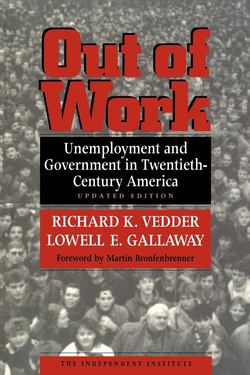Читать книгу Out of Work - Richard K Vedder - Страница 23
На сайте Литреса книга снята с продажи.
A Digression on Unemployment Statistics
ОглавлениеIn the discussion above, we suggested that the labor force could be defined to exclude workers who are conventionally classified as frictionally or structurally unemployed. That may seem artificial and arbitrary. It is important to realize, however, that the official unemployment definition is inherently arbitrary in several ways. For example, at the present time no one under the age of sixteen is included in the labor force, even though there are some child entertainers whose work earns them seven-digit annual incomes. There are millions of housewives and househusbands who “work around the house” doing economically productive activity. Yet they are excluded from the labor force since they do not sell their services in a market. A person working in a child-care facility is “employed”, while a mother who takes care of her own four children at home is “not employed” (as distinct from “unemployed”) even though she probably provides as many (and as high-quality) child care services as the person selling her services in the labor market.
Another problem comes from the fact that many of those persons classified as unemployed in fact have opportunities to work and have chosen not to exercise them. They choose to be unemployed. Suppose an aerospace engineer with graduate degrees is dismissed from his $60,000-a-year job with a defense contractor because of defense cutbacks. Suppose he stops into a local fast-food restaurant after his last day of work and starts talking with his friend, the owner of the restaurant. Suppose further that the friend offers the engineer a job as restaurant manager at a salary of $500 a week ($26,000 a year.) Suppose also that the engineer turns him down. Is the engineer unemployed? Yes, as far as the Bureau of Labor Statistics is concerned, as long as he continues to search for a job similar to his previous one. Clearly, such a definition of “unemployed” fails adequately to convey voluntarily foregone job prospects. Consider figure 2.2. Unemployed individuals have a reservation wage—a minimum wage that they will take as a condition for accepting a new job. A freshly unemployed person may have high aspirations with respect to a new job, expecting a relatively high wage. The longer he or she is unemployed, however, the more likely the worker is to lower the reservation wage, as the reality of job opportunities and the financial pressure of unemployment impact on decisions. Similarly, the longer one searches for a job, the better the job that the unemployed individual is likely to find (although there is an obvious limit to the gains in wages obtainable from more thorough searching.)
FIGURE 2.2 THE DURATION OF UNEMPLOYMENT
In figure 2.2, the individual chooses to take a new job when the best offered position equals (or exceeds) the reservation wage. It is optimal for the individual to remain unemployed for a duration of OX weeks. Government policies might change the reservation wage. For example, if the unemployed receives generous unemployment benefits, he or she may be more choosy about taking a new job. In the context of figure 2.2, unemployment compensation raises the reservation wage to the dotted line, leading to the optimal employment occurring after a longer duration of unemployment. This raises the reported unemployment rate, as well as the natural rate of unemployment.12
There are still other difficulties with the unemployment definition. Some persons become discouraged after long unemployment spells and stop looking for jobs, even though they certainly would like one. They are dropped from the labor force and no longer classified as unemployed, even though in a meaningful sense they are in fact unemployed. Still other problems deal with part-time work, workers in the “underground economy” not included in the government statistics, and with some welfare recipients in workfare programs.13
Some economists believe that the employment-population ratio is a better measure of job opportunities. Over time, that ratio has tended to rise with increased female labor-force participation. For example, in both 1960 and 1988, the civilian unemployment rate was 5.5 percent. Yet 62.6 percent of the noninstutionalized population over sixteen worked in 1988, compared with but 56.8 percent in 1960. By the unemployment measure, job opportunities were similar in both years, but the employment-population ratio tells a different story.
While the imperfections of the unemployment statistics are numerous, to some extent they cancel each other out. While the fact that some people temporarily choose to be unemployed leads to some inflation in the unemployment numbers, so the discouraged-worker effect causes some understatement of the problem. In any case, changes in the unemployment rate from year to year should be a pretty good indicator of changes in employment opportunity, even if the exact magnitude of the statistics is incorrect.
